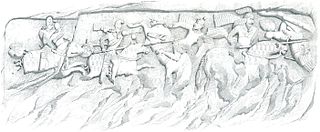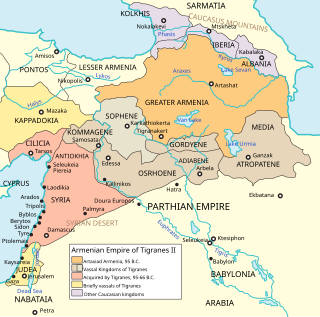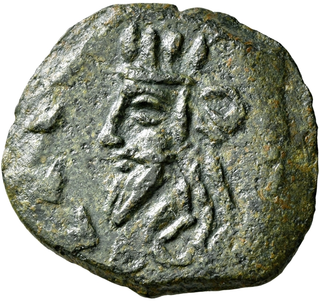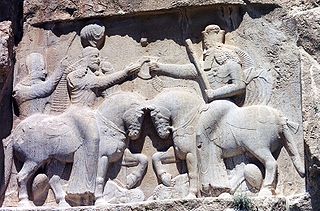Related Research Articles

Marcus Opellius Macrinus was Roman emperor from April 217 to June 218, reigning jointly with his young son Diadumenianus. As a member of the equestrian class, he became the first emperor who did not hail from the senatorial class and also the first emperor who never visited Rome during his reign. Before becoming emperor, Macrinus served under Emperor Caracalla as a praetorian prefect and dealt with Rome's civil affairs. He later conspired against Caracalla and had him murdered in a bid to protect his own life, succeeding him as emperor.
Year 217 (CCXVII) was a common year starting on Wednesday of the Julian calendar. At the time, it was known as the Year of the Consulship of Praesens and Extricatus. The denomination 217 for this year has been used since the early medieval period, when the Anno Domini calendar era became the prevalent method in Europe for naming years.

Diadumenian was the son of the Roman emperor Macrinus and served as his co-ruler for a brief time in 218. His mother, Macrinus' wife, is called Nonia Celsa in the unreliable Historia Augusta, though this name may have been fictional. Diadumenian became caesar in May 217, shortly after his father's accession to the imperial throne. Elagabalus, a relative of the recently deceased Caracalla, revolted in May of the following year, and Diadumenian was elevated to co-emperor. After Macrinus was defeated in the Battle of Antioch on 8 June 218, Diadumenian was sent to the court of Artabanus IV of Parthia to ensure his safety; however, he was captured and executed along the way. After his death and that of his father, the Senate declared both of them enemies of Rome and had their names struck from records and their images destroyed — a process known in modern scholarship as damnatio memoriae.

Ardashir I, also known as Ardashir the Unifier, was the founder of the Persian Sasanian Empire. He was also Ardashir V of the Kings of Persis, until he founded the new empire. After defeating the last Parthian shahanshah Artabanus IV on the Hormozdgan plain in 224, he overthrew the Arsacid dynasty and established the Sasanian dynasty. Afterwards, Ardashir called himself "shahanshah" and began conquering the land that he called Iran.

The Battle of Carrhae was fought in 53 BC between the Roman Republic and the Parthian Empire near the ancient town of Carrhae. An invading force of seven legions of Roman heavy infantry under Marcus Licinius Crassus was lured into the desert and decisively defeated by a mixed cavalry army of heavy cataphracts and light horse archers led by the Parthian general Surena. On such flat terrain, the Legion proved to have no viable tactics against the highly-mobile Parthian horsemen, and the slow and vulnerable Roman formations were surrounded, exhausted by constant attacks, and eventually crushed. Crassus was killed along with the majority of his army. It is commonly seen as one of the earliest and most important battles between the Roman and Parthian Empires and one of the most crushing defeats in Roman history. According to the poet Ovid in Book 6 of his poem Fasti, the battle occurred on 9 June.

Orodes II, was King of Kings of the Parthian Empire from 57 BC to 37 BC. He was a son of Phraates III, whom he murdered in 57 BC, assisted by his elder brother Mithridates IV. The two brothers quickly fell out and entered into a dynastic struggle, in which Orodes was triumphant.

Artavasdes II, also known as Artavazd II, was king of Armenia from 55 BC to 34 BC. A member of the Artaxiad dynasty, he was the son and successor of Tigranes the Great, who ascended the throne of a still powerful and independent state. His mother was Cleopatra of Pontus, thus making his maternal grandfather the prominent King of Pontus Mithridates VI Eupator. Like his father, Artavasdes continued using the title of King of Kings, as seen from his coins.

Artabanus IV, also known as Ardavan IV (Parthian:𐭓𐭕𐭐𐭍), incorrectly known in older scholarship as Artabanus V, was the last ruler of the Parthian Empire from c. 213 to 224. He was the younger son of Vologases V, who died in 208.
Tiridates III of Parthia, ruled the Parthian Empire briefly in 35–36. He was the grandson of Phraates IV. He was sent to Rome as a hostage and was educated there.

The Battle of Antioch was fought between the Roman army of the Emperor Macrinus and his rival Elagabalus, whose troops were commanded by General Gannys, probably a short distance from Antioch. Gannys' victory over Macrinus led to the downfall of the emperor and his replacement by Elagabalus.

Relations between the Roman and Iranian states were established c. 92 BC. It was in 69 BC that the two states clashed for the first time; the political rivalry between the two empires would dominate much of Western Asia and Europe until 628. Initially commencing as a rivalry between the Parthians and Rome, from the 3rd to mid-7th centuries the Roman Empire and its rival Sassanid Persia were recognized as two of the leading powers in the world.
The Roman–Persian Wars, also known as the Roman–Iranian Wars, were a series of conflicts between states of the Greco-Roman world and two successive Iranian empires: the Parthian and the Sasanian. Battles between the Parthian Empire and the Roman Republic began in 54 BC; wars began under the late Republic, and continued through the Roman and Sasanian empires. A plethora of vassal kingdoms and allied nomadic nations in the form of buffer states and proxies also played a role. The wars were ended by the early Muslim conquests, which led to the fall of the Sasanian Empire and huge territorial losses for the Byzantine Empire, shortly after the end of the last war between them.

The Parthian Empire, also known as the Arsacid Empire, was a major Iranian political and cultural power centered in ancient Iran from 247 BC to 224 AD. Its latter name comes from its founder, Arsaces I, who led the Parni tribe in conquering the region of Parthia in Iran's northeast, then a satrapy (province) under Andragoras, who was rebelling against the Seleucid Empire. Mithridates I greatly expanded the empire by seizing Media and Mesopotamia from the Seleucids. At its height, the Parthian Empire stretched from the northern reaches of the Euphrates, in what is now central-eastern Turkey, to present-day Afghanistan and western Pakistan. The empire, located on the Silk Road trade route between the Roman Empire in the Mediterranean Basin and the Han dynasty of China, became a center of trade and commerce.

The Battle of Hormozdgan was the climactic battle between the Arsacid and the Sasanian dynasties that took place on 28 April 224. The Sasanian victory broke the power of the Parthian dynasty, effectively ending almost five centuries of Parthian rule in Iran, and marking the official start of the Sasanian era.
The Roman–Parthian Wars were a series of conflicts between the Parthian Empire and the Roman Republic and Roman Empire. It was the first series of conflicts in what would be 682 years of Roman–Persian Wars.

The Parthian war of Caracalla was an unsuccessful campaign by the Roman Empire under Caracalla against the Parthian Empire in 216–17 AD. It was the climax of a four-year period, starting in 213, when Caracalla pursued a lengthy campaign in central and eastern Europe and the Near East. After intervening to overthrow rulers in client kingdoms adjoining Parthia, he invaded in 216 using an abortive wedding proposal to the Parthian king Artabanus's daughter as a casus belli. His forces carried out a campaign of massacres in the northern regions of the Parthian Empire before withdrawing to Asia Minor, where he was assassinated in April 217. The war was ended the following year after Parthian victory at the Battle of Nisibis, with the Romans paying a huge sum of war reparations to the Parthians.
The Grivpanvar were an elite late Parthian and Sasanian division who fought as heavy cataphract cavalry. According to Roman sources, the Grivpanvar had the ability to impale two men on the long, heavy spears that they carried. Historical evidence suggests that the heavily armoured Parthian grivpanvar were at least partially influenced by the military of the Central Asian steppes, who in turn had inherited their armoured cavalry traditions from the Massagetae and the late Achaemenid Persians.

Tiridates II, flourished second half of the 2nd century - died 252), known in Armenian sources as Khosrov, was an Arsacid Prince who served as a Roman Client King of Armenia. Tiridates II was the son and heir of the Armenian King Khosrov I.

The Sassanid campaign of Alexander Severus was an episode of the Roman–Sasanian Wars (224-363) that saw the Roman Empire ruled by Emperor Alexander Severus (222-235) confront the dominance of the Sasanids, led by Ardashir I (224-241): the war was fought between 230 and 232, originating from an attempted Sasanian expansion into the eastern Roman provinces, and resolved with a return to the status quo ante.

The Mesopotamian campaigns of Ardashir I represented the first episode in a new period of wars between the Romans and Sasanids. The war between the Roman Empire, ruled by the Roman emperor Severus Alexander (222-235), and the Sasanian rule, led by Ardashir I (224-241), lasted for more than a decade, from 229 to 241 when the Sasanian ruler died and was replaced by his son, Shapur I.
References
- ↑ The Oxford Handbook of Iranian History, ed.Touraj Daryaee, (Oxford University Press, 2012), 178;"A Parthian counteroffensive defeated them in the battle of Nisibis"
- 1 2 Rawlinson, Ch. XXI
- ↑ Herodian, IV.10.1-2
- ↑ Herodian, IV.11.1-2
- ↑ Herodian, IV.11.5-7
- ↑ Herodian, IV.13
- ↑ Cassius Dio, Roman History, Book LXXIX.26
- ↑ Herodian, IV.15.1
- ↑ Herodian, IV.15.2-3
- ↑ Herodian refers only to a deep formation, but it is possible that the Romans were formed up in some sort of triple line. On the triplex acies in the 2nd and 3rd centuries, see M.P. Speidel, The Framework of an Imperial Legion (Cardiff 1992).
- ↑ Herodian, IV.15.4
- ↑ It is noteworthy that this tactic had been recommended by Cassius to Crassus against the Parthians at Carrhae, but Crassus did not follow it. Cowan, Roman Battle Tactics, p. 20
- ↑ Herodian, IV.15.5
- ↑ Cassius Dio, Roman History, Book LXXIX.27
- ↑ Herodian, IV.15.7-8